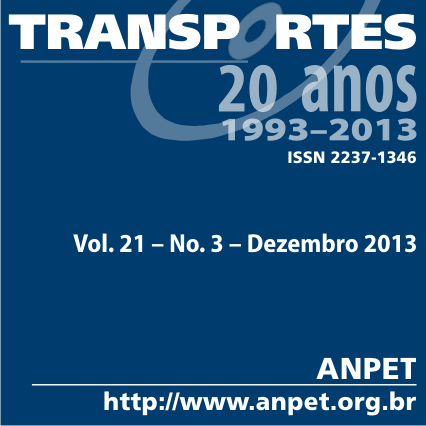Mainstream Traffic Flow Control on Freeways Using Variable Speed Limits
DOI:
https://doi.org/10.4237/transportes.v21i3.694Abstract
Controle do Fluxo Principal (CFP), realizado via limites de velocidade variáveis, é um conceito de controle para o gerenciamento em tempo real do tráfego em rodovias. Os benefícios de CFP para a fluidez do tráfego foram demonstrados por pesquisas recentes que utilizaram uma abordagem de controle ótimo e uma abordagem de controle realimentado. Neste artigo, as duas abordagens de controle são revisadas e aplicadas a uma malha rodoviária em um ambiente de simulação. O modelo utilizado da malha rodoviária, que reproduz um anel viário real, foi validado e alimentado com demandas medidas em campo. Os resultados de controle ótimo e controle realimentado são discutidos e comparados, e produzem melhora significativa no desempenho do sistema. A estrutura de controle realimentado é considerada apropriada para a aplicação em campo, uma vez que considera requisitos e restrições operacionais, e apresenta resultados satisfatórios. Além disto, o desempenho do sistema de controle mostrou pouca sensibilidade a variações nos parâmetros do controlador realimentado. Este resultado indica que os esforços para sintonia do controlador em campo podem ser reduzidos.Downloads
References
Alessandri, A.; A. Di Febbraro; A. Ferrara and E. Punta (1998) Optimal Control of Freeways via Speed Signalling and Ramp Metering. Control Engineering Practice, v. 6, n. 6, p. 771–780. DOI:10.1016/S0967-0661(98)00083-5.
Alfaro, V. M. (2007) PID Controllers’ Fragility. ISA Transactions, v. 46, n. 4, p. 555–559. DOI:10.1016/j.isatra.2007.03.006.
Carlson, R. C.; D. Manolis; I. Papamichail and M. Papageorgiou (2012) Integrated Ramp Metering and Mainstream Traffic Flow Control of Motorways Using Variable Speed Limits. Procedia - Social and Behavioral Sciences, v. 48, n. , p. 1578-1588. DOI:10.1016/j.sbspro.2012.06.1133.
Carlson, R. C.; I. Papamichail and M. Papageorgiou (2013) Comparison of Local Feedback Controllers for the Mainstream Traffic Flow on Freeways Using Variable Speed Limits. Journal of Intelligent Transportation Systems: technology, planning, and operations. Available at: <http://dx.doi.org/10.1080/15472450.2012.721330>. Accessed: 17 aug. 2012. DOI:10.1080/15472450.2012.721330.
Carlson, R. C.; I. Papamichail and M. Papageorgiou (2011a) Local Feedback-based Mainstream Traffic Flow Control on Motorways Using Variable Speed Limits. IEEE Transactions on Intelligent Transportation Systems, v. 12, n. 4, p. 1261–1276. DOI:10.1109/TITS.2011.2156792.
Carlson, R. C.; I. Papamichail; M. Papageorgiou and A. Messmer (2010a) Optimal Mainstream Traffic Flow Control of Large-scale Motorway Networks. Transportation Research Part C: Emerging Technologies, v. 18, n. 2, p. 193–212. DOI:10.1016/j.trc.2009.05.014.
Carlson, R. C.; I. Papamichail; M. Papageorgiou and A. Messmer (2010b) Optimal Motorway Traffic Flow Control Involving Variable Speed Limits and Ramp Metering. Transportation Science, v. 44, n. 2, p. 238–253. DOI:10.1287/trsc.1090.0314.
Carlson, R. C.; A. Ragias; I. Papamichail and M. Papageorgiou (2011b) Mainstream Traffic Flow Control of Merging Motorways Using Variable Speed Limits. Proceedings of The 19th Mediterranean Conference on Control and Automation. Corfu, Greece, p. 674–681. DOI:10.1109/MED.2011.5983115.
Chiang, Y. H. and J. C. Juang (2008) Control of Freeway Traffic Flow in Unstable Phase by H-infinity Theory. IEEE Transactions on Intelligent Transportation Systems, v. 9, n. 2, p. 193–208. DOI:10.1109/TITS.2008.922875.
Chung, K.; J. Rudjanakanoknad and M. Cassidy (2007) Relation Between Traffic Density and Capacity Drop at Three Freeway Bottlenecks. Transportation Research Part B: Methodological, v. 41, n. 1, p. 82–95. DOI:10.1016/j.trb.2004.12.001.
Ellis, G. (2004) Control System Design Guide: a practical guide. Elsevier Academic Press,, Amsterdam.
European Comission (2011) Roadmap to a single European transport area – towards a competitive and resource efficient transport system. European Comission, Brussels, Belgium.
Gazis, D. C. and R. S. Foote (1969) Surveillance and Control of Tunnel Traffic by an On-line Digital Computer. Transportation Science, v. 3, n. 3, p. 255–275. DOI:10.1287/trsc.3.3.255.
Greenberg, H. and A. Daou (1960) The Control of Traffic Flow to Increase Flow. Operations Research, v. 8, n. 4, p. 524–532.
Hegyi, A. and S. P. Hoogendoorn (2010) Dynamic Speed Limit Control to Resolve Shock Waves on Freeways - Field Test Results of the SPECIALIST Algorithm. 13th International IEEE Conference on Intelligent Transportation Systems. Funchal, Madeira Island, Portugal, p. 519–524. DOI:10.1109/ITSC.2010.5624974.
Hegyi, A.; B. De Schutter and H. Hellendoorn (2005) Model Predictive Control for Optimal Coordination of Ramp Metering and Variable Speed Limits. Transportation Research Part C: Emerging Technologies, v. 13, n. 3, p. 185–209. DOI:10.1016/j.trc.2004.08.001.
IEEE (2011) The Impact of Control Technology. Available at: <http://www.ieeecss.org>. Accessed: 19 may. 2012.
Isermann, R. (2011) Perspectives of Automatic Control. Control Engineering Practice, v. 19, n. 12, p. 1399–1407. DOI:10.1016/j.conengprac.2011.08.004.
Kotsialos, A.; M. Papageorgiou; C. Diakaki; Y. Pavlis and F. Middelham (2002a) Traffic Flow Modeling of Large-scale Motorway Networks Using the Macroscopic Modeling Tool METANET. IEEE Transactions on Intelligent Transportation Systems, v. 3, n. 4, p. 282–292. DOI:10.1109/TITS.2002.806804.
Kotsialos, A.; M. Papageorgiou; M. Mangeas and H. Haj-Salem (2002b) Coordinated and Integrated Control of Motorway Networks via Non-linear Optimal Control. Transportation Research Part C: Emerging Technologies, v. 10, n. 1, p. 65–84. DOI:10.1016/S0968-090X(01)00005-5.
Lin, P.-W.; K.-P. Kang and G.-L. Chang (2004) Exploring the Effectiveness of Variable Speed Limit Controls on Highway Work-zone Operations. Journal of Intelligent Transportation Systems, v. 8, n. 3, p. 155–168. DOI:10.1080/15472450490492851.
Messmer, A. and M. Papageorgiou (1990) METANET: a Macroscopic Simulation Program for Motorway Networks. Traffic Engineering and Control, v. 31, n. 8, p. 466–470.
Papageorgiou, M.; E. Kosmatopoulos and I. Papamichail (2008) Effects of Variable Speed Limits on Motorway Traffic Flow. Transportation Research Record: Journal of the Transportation Research Board, v. 2047, p. 37–48. DOI:10.3141/2047-05.
Papageorgiou, M. and A. Kotsialos (2002) Freeway Ramp Metering: an Overview. IEEE Transactions on Intelligent Transportation Systems, v. 3, n. 4, p. 271–281. DOI:10.1109/TITS.2002.806803.
Papamichail, I.; A. Kotsialos; I. Margonis and M. Papageorgiou (2010) Coordinated Ramp Metering for Freeway Networks – a Model-predictive Hierarchical Control Approach. Transportation Research Part C: Emerging Technologies, v. 18, n. 3, p. 311–331. DOI:10.1016/j.trc.2008.11.002.
Popov, A.; R. Babuska; A. Hegyi and H. Werner (2008) Distributed Controller Design for Dynamic Speed Limit Control Against Shock Waves on Freeways. Proceedings of The 17th IFAC World Congress. Seoul, Korea, p. 14060–14065. DOI:10.3182/20080706-5-KR-1001.02380.
Schrank, D.; T. Lomax and S. Turner (2010) Urban Mobility Report 2010. Texas Transportation Institute, The Texas A&M University System. Available at: <http://mobility.tamu.edu>. Accessed: 22 may. 2011.
Zhang, J.; H. Chang and P. A. Ioannou (2006) A Simple Roadway Control System for Freeway Traffic. 2006 American Control Conference. Minneapolis, MN, USA, p. 4900–4905. DOI:10.1109/ACC.2006.1657497.
Downloads
Published
How to Cite
Issue
Section
License
Authors who submit papers for publication by TRANSPORTES agree to the following terms:
- The authors retain the copyright and grant Transportes the right of first publication of the manuscript, without any financial charge, and waive any other remuneration for its publication by ANPET.
- Upon publication by Transportes, the manuscript is automatically licensed under the Creative Commons License CC BY 4.0 license. This license permits the work to be shared with proper attribution to the authors and its original publication in this journal, and to be adapted for non-commercial purposes, provided appropriate credit is given and any derivative works are distributed under the same terms.
- Authors are authorized to enter into additional separate contracts for the non-exclusive distribution of the version of the manuscript published in this journal (e.g., publishing in an institutional repository or as a book chapter), with recognition of the initial publication in this journal, provided that such a contract does not imply an endorsement of the content of the manuscript or the new medium by ANPET.
- Authors are permitted and encouraged to publish and distribute their work online (e.g., in institutional repositories or on their personal websites) after the editorial process is complete. As Transportes provides open access to all published issues, authors are encouraged to use links to the DOI of their article in these cases.
- Authors guarantee that they have obtained the necessary authorization from their employers for the transfer of rights under this agreement, if these employers hold any copyright over the manuscript. Additionally, authors assume all responsibility for any copyright infringements by these employers, releasing ANPET and Transportes from any responsibility in this regard.
- Authors assume full responsibility for the content of the manuscript, including the necessary and appropriate authorizations for the disclosure of collected data and obtained results, releasing ANPET and Transportes from any responsibility in this regard.









